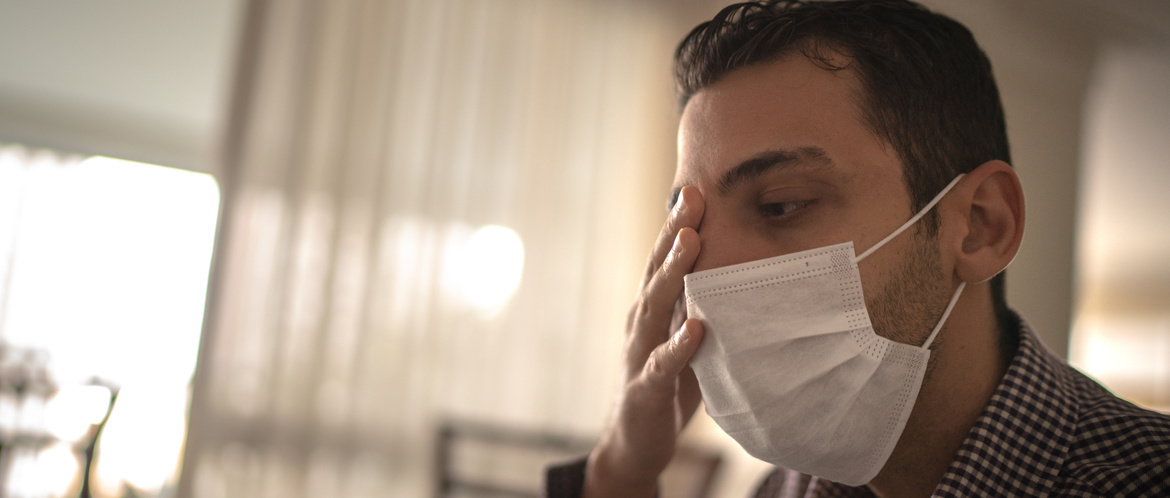
Välj en kanal
Kolla in de olika Progress in Mind-kanalerna.

Progress in Mind

Headache is emerging as one of the most frequent neurological symptoms of Covid-19 reported in up to one in five positive cases,1-4 said Dr David Garcia-Azorin, Valladolid, Spain speaking at #MTIS2020. The onset of headache occurs early in the disease course and its presence is identified as an independent predictor of lower risk of mortality in Covid-19 hospitalized patients.3 Often presenting as a bilateral, severe, pressing headache with frontal predominance, the phenotype combines tension-type headache with migraine features.5,6
Headache occurs early-on and can persist
Dr David Garcia-Azorin presented results of a study of Covid-19 patients conducted at the Hospital Clinico Universitario de Valladolid, Spain from 8 March to 11 April 2020.4,7 The aim was to estimate frequency of headache in Covid-19 patients and to characterize the phenotype of headache attributed to Covid-19. The study included 458 people aged over 18 years (mean age 51 years; 72% female) with confirmed Covid-19 infection and reporting headache (around 22% of all Covid-19 infections).4
Headache is a common non-respiratory symptom of Covid-19 that should not be overlooked
Headache was the first symptom of Covid-19 reported by 28% of people and 16% reported headache as the most bothersome symptom.7 Nearly 50% of people in this Covid-19 population had a prior history of headache (migraine 18%, tension-type headache 22%). The headache lasted for a median duration of 7 days (range 4-14 days) and persisted for 1 month for 13% of Covid-19 outpatients and 36% of hospitalized Covid-19 patients.
Headache, as a Covid-19 symptom, is long lasting with typical duration of 1 week but persisting for 1 month in some patients
Migraine features with Covid-19 headache
70% of Covid-19 patients with headache reported associated migraine features, which included: photophobia in 33% of patients, phonophobia (32%), avoidance of physical activity (67%), nausea (16%), vomiting (5%), worsening by head movement (31%).7 The quality of headache pain was described as pressing, throbbing, and stabbing and was most frequently bilateral and frontal although hospitalized Covid-19 patients more frequently had unilateral pain.
70% of Covid-19 patients with headache also report migraine symptoms, including photophobia, phonophobia, nausea, vomiting, avoidance of physical activity and worsening by head movement
Migraine experience in the Covid-19 era
The impact of Covid-19 on the health of people with migraine was explored in two other studies reported at #MTIS2020. Early lockdown measures could have affected migraine triggers, such as stress and anxiety, and the frequency of migraine.8,9
During early 2020 (January to April) the proportion of most common migraine triggers – including stress, lack of sleep, neck pain and anxiety – decreased by a small degree compared with the same period in 2019 and 2018, as reported by users of the Migraine Buddy app (N = >150,000 worldwide).10 However, a small increase in migraine frequency was reported during the last 3 years, which could reflect a real increase, change in reporting habits, or change in make-up of the Migraine Buddy app users.
Conversely, a small cohort study of 592 patients in the Netherlands found a reduction in migraine for patients who completed a migraine headache e-diary for 1 month during lockdown (compared with 1 month pre-lockdown). Mean monthly migraine days decreased by 0.5 days, use of acute medication decreased by 0.5 days/month and general well-being improved.11 The ongoing impact of Covid-19 on people with migraine needs further exploration in longitudinal studies.
Our correspondent’s highlights from the symposium are meant as a fair representation of the scientific content presented. The views and opinions expressed on this page do not necessarily reflect those of Lundbeck.